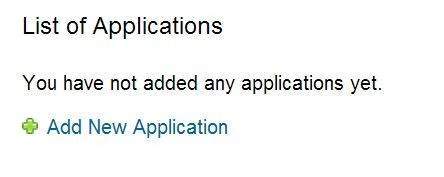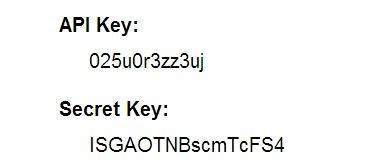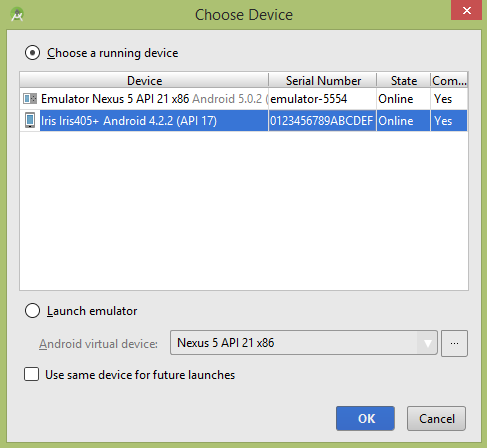Android allows your application to connect to Linkedin and share data or any kind of updates on Linkedin. This chapter is about integrating Linkedin into your application.
There are two ways through which you can integrate Linkedin and share something from your application. These ways are listed below.
- Linkedin SDK (Scribe)
- Intent Share
Integrating Linkedin SDK
This is the first way of connecting with Linkedin. You have to register your application and then receive some Application Id , and then you have to download the Linkedin SDK and add it to your project. The steps are listed below.
Registering your application
Create a new Linkedin application at https://www.linkedin.com/secure/developer. Click on add new application. It is shown below −

Now fill in your application name , description and your website url. It is shown below −

If everything works fine, you will receive an API key with the secret. Just copy the API key and save it somewhere. It is shown in the image below −

Downloading SDK and integrating it
Download Linkedin sdk here. Copy the scribe-1.3.0.jar jar into your project libs folder.
Posting updates on Linkedin application
Once everything is complete, you can run the Linkedin samples which can be found here.
Intent share
Intent share is used to share data between applications. In this strategy, we will not handle the SDK stuff, but let the Linkedin application handles it. We will simply call the Linkedin application and pass the data to share. This way, we can share something on Linkedin.
Android provides intent library to share data between activities and applications. In order to use it as share intent, we have to specify the type of the share intent to ACTION_SEND. Its syntax is given below −
Intent shareIntent = new Intent(); shareIntent.setAction(Intent.ACTION_SEND);
Next thing you need to is to define the type of data to pass , and then pass the data. Its syntax is given below −
shareIntent.setType("text/plain"); shareIntent.putExtra(Intent.EXTRA_TEXT, "Hello, from tutorialspoint"); startActivity(Intent.createChooser(shareIntent, "Share your thoughts"));
Apart from the these methods , there are other methods available that allows intent handling. They are listed below −
| Sr.No | Method & description |
|---|---|
| 1 |
addCategory(String category)
This method add a new category to the intent.
|
| 2 |
createChooser(Intent target, CharSequence title)
Convenience function for creating a ACTION_CHOOSER Intent
|
| 3 |
getAction()
This method retrieve the general action to be performed, such as ACTION_VIEW
|
| 4 |
getCategories()
This method return the set of all categories in the intent.nt and the current scaling event
|
| 5 |
putExtra(String name, int value)
This method add extended data to the intent.
|
| 6 |
toString()
This method returns a string containing a concise, human-readable description of this object
|
Example
Here is an example demonstrating the use of IntentShare to share data on Linkedin. It creates a basic application that allows you to share some text on Linkedin.
To experiment with this example, you can run this on an actual device or in an emulator.
| Steps | Description |
|---|---|
| 1 | You will use Android studio to create an Android application under a package com.example.sairamkrishna.myapplication. |
| 2 | Modify src/MainActivity.java file to add necessary code. |
| 3 | Modify the res/layout/activity_main to add respective XML components |
| 4 | Run the application and choose a running android device and install the application on it and verify the results |
Following is the content of the modified main activity file MainActivity.java.
package com.example.sairamkrishna.myapplication; import android.content.Intent; import android.net.Uri; import android.os.Bundle; import android.support.v7.app.AppCompatActivity; import android.view.View; import android.widget.Button; import android.widget.ImageView; import java.io.FileNotFoundException; import java.io.InputStream; public class MainActivity extends AppCompatActivity { private ImageView img; protected void onCreate(Bundle savedInstanceState) { super.onCreate(savedInstanceState); setContentView(R.layout.activity_main); img = (ImageView) findViewById(R.id.imageView); Button b1 = (Button) findViewById(R.id.button); b1.setOnClickListener(new View.OnClickListener() { @Override public void onClick(View v) { Intent sharingIntent = new Intent(Intent.ACTION_SEND); Uri screenshotUri = Uri.parse("android. resource://comexample.sairamkrishna.myapplication/*"); try { InputStream stream = getContentResolver().openInputStream(screenshotUri); } catch (FileNotFoundException e) { // TODO Auto-generated catch block e.printStackTrace(); } sharingIntent.setType("image/jpeg"); sharingIntent.putExtra(Intent.EXTRA_STREAM, screenshotUri); startActivity(Intent.createChooser(sharingIntent, "Share image using")); } }); } }
Following is the modified content of the xml res/layout/activity_main.xml.
In the below code abc indicates the logo of tutorialspoint.com
<?xml version="1.0" encoding="utf-8"?> <RelativeLayout xmlns:android="http://schemas.android.com/apk/res/android" xmlns:tools="http://schemas.android.com/tools" android:layout_width="match_parent" android:layout_height="match_parent" android:paddingLeft="@dimen/activity_horizontal_margin" android:paddingRight="@dimen/activity_horizontal_margin" android:paddingTop="@dimen/activity_vertical_margin" android:paddingBottom="@dimen/activity_vertical_margin" tools:context=".MainActivity"> <TextView android:layout_width="wrap_content" android:layout_height="wrap_content" android:id="@+id/textView" android:layout_alignParentTop="true" android:layout_centerHorizontal="true" android:textSize="30dp" android:text="Linkedin Share" /> <TextView android:layout_width="wrap_content" android:layout_height="wrap_content" android:text="Tutorials Point" android:id="@+id/textView2" android:layout_below="@+id/textView" android:layout_centerHorizontal="true" android:textSize="35dp" android:textColor="#ff16ff01" /> <ImageView android:layout_width="wrap_content" android:layout_height="wrap_content" android:id="@+id/imageView" android:layout_below="@+id/textView2" android:layout_centerHorizontal="true" android:src="@drawable/logo"/> <Button android:layout_width="wrap_content" android:layout_height="wrap_content" android:text="Share" android:id="@+id/button" android:layout_marginTop="61dp" android:layout_below="@+id/imageView" android:layout_centerHorizontal="true" /> </RelativeLayout>
Following is the content of AndroidManifest.xml file.
<?xml version="1.0" encoding="utf-8"?> <manifest xmlns:android="http://schemas.android.com/apk/res/android" package="com.example.sairamkrishna.myapplication" > <application android:allowBackup="true" android:icon="@mipmap/ic_launcher" android:label="@string/app_name" android:theme="@style/AppTheme" > <activity android:name=".MainActivity" android:label="@string/app_name" > <intent-filter> <action android:name="android.intent.action.MAIN" /> <category android:name="android.intent.category.LAUNCHER" /> </intent-filter> </activity> </application> </manifest>
Let's try to run your application. I assume you have connected your actual Android Mobile device with your computer. To run the app from Android studio, open one of your project's activity files and click Run  icon from the toolbar. Before starting your application, Android studio will display following window to select an option where you want to run your Android application.
icon from the toolbar. Before starting your application, Android studio will display following window to select an option where you want to run your Android application.
 icon from the toolbar. Before starting your application, Android studio will display following window to select an option where you want to run your Android application.
icon from the toolbar. Before starting your application, Android studio will display following window to select an option where you want to run your Android application.
No comments:
Post a Comment